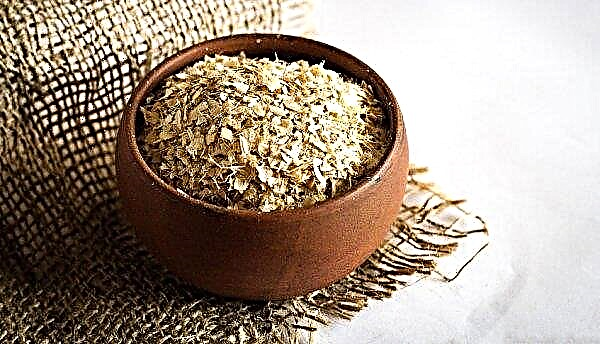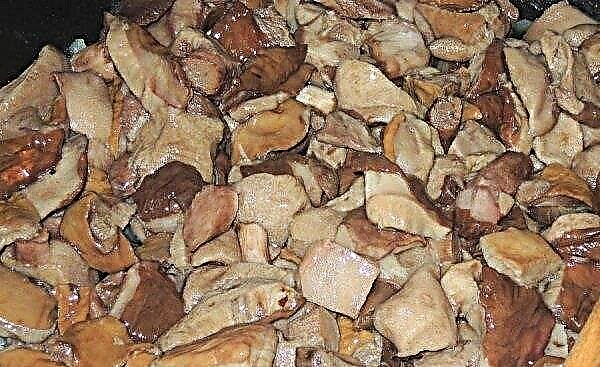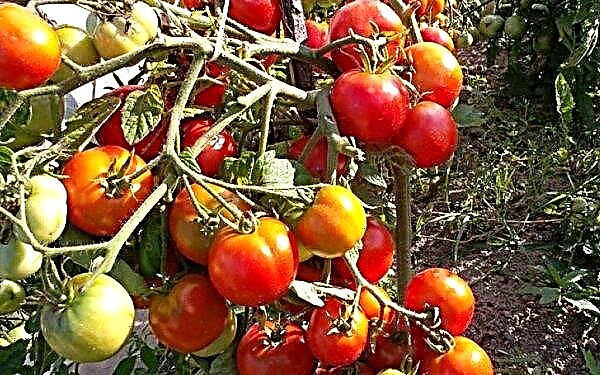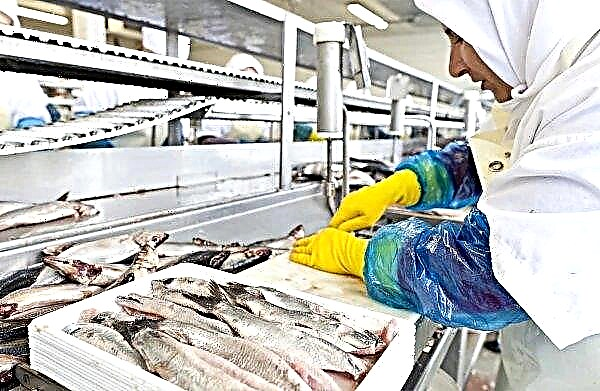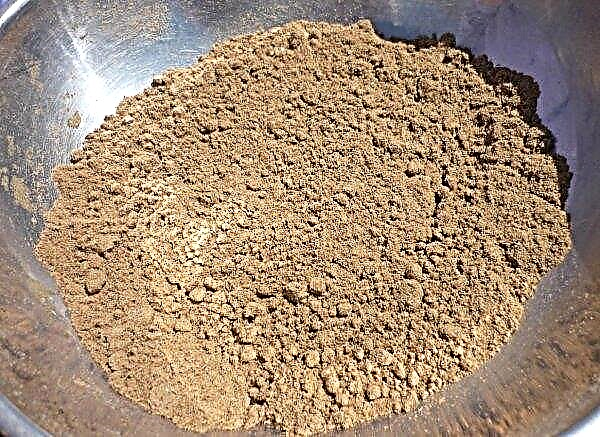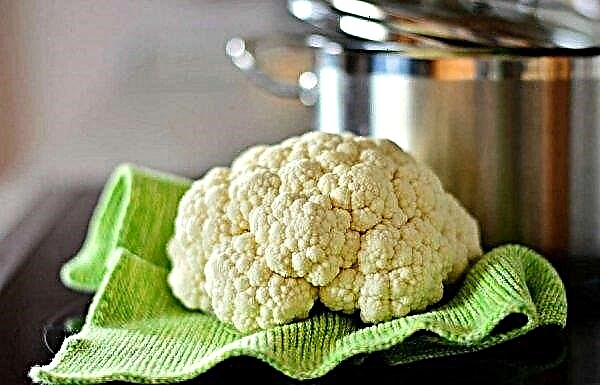Since ancient times, mushrooms have been eaten, they are not only tasty, but also a very useful product with a high protein content. A rare feast without pickled or fried mushrooms. Why this particular type of mushroom is so popular, what is its use and whether it can be harmful, will be considered in the article.
Description
In general, the name "honey agaric" combines over 20 species of edible mushrooms that have similar characteristics. However, among mushroom pickers, it is traditionally applied to summer, autumn and winter honey agarics growing around stumps, which is what their name is due to.
Did you know? The honey agaric is characterized by a growth as fast as that of bamboo, so, after rain, the mushroom is able to grow by 0.5 cm in just 1 minute.
Outwardly, this species is small in size and may vary depending on the variety:
- winter mushrooms have a hat 2-10 cm, the color of which can vary from light yellow to brown with an orange tint. The leg can grow up to 7 cm, has a tubular structure and is painted brown, the surface is velvety. They grow mainly on stumps and trunks of deciduous trees in the autumn-winter period;
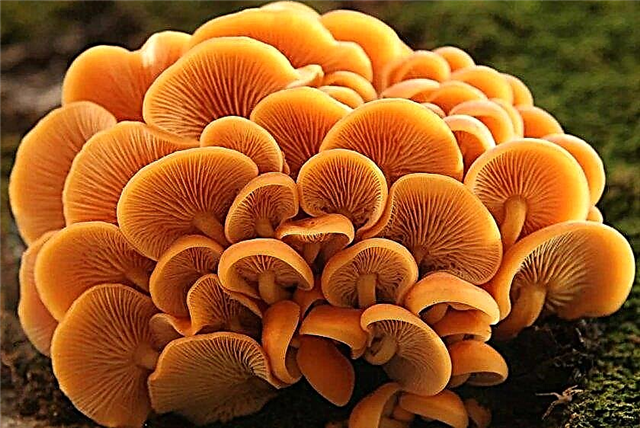
- autumn honey fly grows in large groups, most often found near trees such as alder, birch, aspen, but is able to parasitize on almost any vegetation. The mushroom bears fruit from the beginning of September until the first winter colds. A distinctive feature of the representatives of this family is a large hat, usually it grows up to 15–17 cm, and the fungus can reach a height of 10 cm. The shape of the hat changes with the maturity of the fungus, young ones have bulging hats, and more mature ones are flat. Color can vary from greenish to dark brown, but the leg will always be light brown;
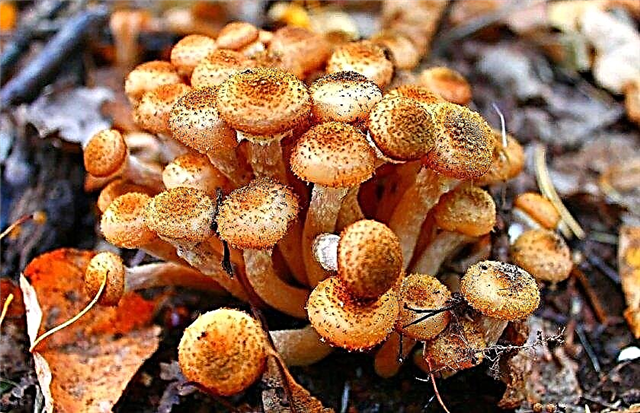
- summer mushrooms are most often usedto pickle or salt, due to their size. As a rule, such mushrooms grow up to only 7 cm in height, their hats are small and do not exceed 6 cm. These babies grow in large groups, parasitizing on rotten trees and stumps. You can collect them from spring until the first November cold weather. The mushroom hats have a glossy surface, can have a color from dark yellow to brown, the leg is brown.
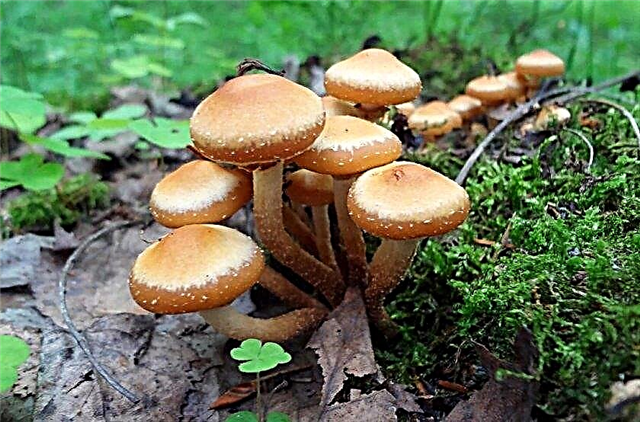
Nutrition value of fried and boiled mushrooms
In order to properly form a healthy diet by including mushrooms in it, you must clearly know what nutritional value they have and how it changes depending on the method of preparation of the product. After heat treatment by boiling the product, there is a decrease in its calorie content compared to fresh, due to the fact that the fungus loses all the water and dietary fiber contained in it. Cooking is practically not reflected in the composition of the BZHU.
Thus, 100 grams of boiled mushrooms contains:
- proteins - 2.1 g;
- fats - 1.2 g;
- carbohydrates - 0.4 g.
The composition leaves 5 g of dietary fiber and 90 g of water. Calorie content of the product is 15.5 kcal. But fried honey mushrooms, beloved by all, are by no means an example of a useful product in terms of nutrition.
Important! Before collecting honey mushrooms, you must clearly make sure that it is them, because this species has many poisonous brethren, the consumption of which can be deadly! The main difference between poisonous twins is the absence of a ring characteristic of honey mushrooms under a hat.
As a result of frying in oil, the nutritional value of the product changes significantly:
- proteins - 1.9 g;
- fats - 3.5 g;
- carbohydrates - 3.1 g.
Moreover, the calorie content of this dish will be 47 kcal in 100 grams of product.
 Undercooked mushrooms can lead to eating disorder, therefore it is recommended to boil mushrooms for at least 40 minutes.
Undercooked mushrooms can lead to eating disorder, therefore it is recommended to boil mushrooms for at least 40 minutes.
Composition and calorie content
Everyone knows that mushrooms are a very useful product, especially for those who decide to exclude sources of animal protein from their diet, replacing it with vegetable. To assess their usefulness, you need to familiarize yourself with what and how much they have in their composition.
Vitamins and BJU
As mentioned above, this product is high in protein, as well as healthy fiber. The calorie content of raw mushrooms is 22 kcal per serving weighing 100 grams.
The ratio of BJU in the raw product:
- proteins - 2.1 g;
- fats - 1.2 g;
- carbohydrates - 0.5 g.
Dietary fiber - 5 g. The main vitamins that make up the pulp of this species are B vitamins (B1, B3, B5, B6, B9) and vitamin C. According to nutritionists, the daily consumption of 100 grams of honey mushrooms is able to fill the daily need of the human body for vitamins B.
Minerals and minerals
The mineral composition of honey mushrooms is not too wide, but its uniqueness is that it includes the most necessary substances in high concentration.

Macronutrients:
- potassium - 400 mg;
- phosphorus - 45 mg;
- magnesium - 20 mg;
- sodium - 5 mg;
- calcium - 5 mg.
In terms of phosphorus content, the product is comparable to fish meat. The microelement composition is not very diverse, but rich in useful substances: iron, iodine, selenium, lithium, copper, zinc, as well as monounsaturated and polyunsaturated fatty acids.
Did you know? In the state of Oregon in the United States grows the largest in the world of mushrooms. Its mycelium is distributed in the soil on an area of over 850 ha, and age is estimated at least 2000 years.
Useful properties for the human body
So, having studied the composition of nutrients contained in honey mushrooms, we can assume that they bring significant benefits to humans.
- What specific properties this product possesses will be considered further:
- First of all, it is worth noting that this fungus is a source of easily digestible protein and does not overload the digestive system;
- the composition contains natural substances that have an antimicrobial effect, which is why the use of honey mushrooms can help in the fight against Staphylococcus aureus, normalize the intestinal microflora;
- the iron, copper, zinc contained in the product contribute to the restoration of hemoglobin levels in case of iron deficiency anemia;
- regular consumption of this fungus in food allows you to replenish vitamin B reserves, which in turn has a beneficial effect on metabolism and the work of the endocrine system.
Contraindications
Mushrooms themselves are considered heavy food due to the high amount of fiber. Abuse of this delicacy is fraught with indigestion, heaviness in the stomach and other digestive disorders. In this regard, it is not recommended to eat mushrooms for people suffering from diseases of the stomach and intestines, especially in the acute stage, as well as children under 3 years of age due to the immaturity of the digestive system.

Consequences and possible harm
Despite the obvious benefits of forest mushrooms, they are not always useful and not for everyone. Under certain circumstances, the product can be harmful. First of all, it is worth recalling that honey mushrooms are easily confused with poisonous brethren containing dangerous toxins, which can cause severe poisoning, requiring emergency medical attention. Inadequate heat treatment of mushrooms can lead to diarrhea.
Is it possible for pregnant fried mushrooms
Very often, expectant mothers feel like pampering themselves with delicious pickled or fried mushrooms. Undoubtedly, the question arises about the permissibility of eating mushrooms pregnant.
Gynecologists recommend approaching this issue soundly:
- women in a position are categorically forbidden to eat mushrooms purchased in natural markets or collected independently without experience in identifying false honey mushrooms; you can only buy a product in trusted stores;
- limit the amount of servings and eat the dish no more than 1-2 times a week;
- try to give preference not to fried, but to stewed or boiled mushrooms in order to lessen the load on the pancreas.

So, having considered the description and properties of forest mushrooms, we can confidently conclude that they are of high nutritional value and usefulness. However, it is important to remember that the basic rules of use are caution when choosing and moderation in the amount of servings.








